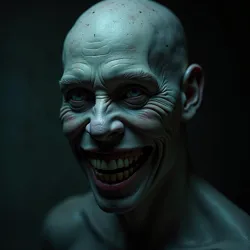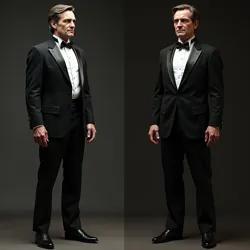Partygoers
 The characteristic frozen grin of a Partygoer, as depicted in The Backrooms Trilogy
The characteristic frozen grin of a Partygoer, as depicted in The Backrooms TrilogyPartygoers are among the most notorious and dangerous entities encountered within the Backrooms, achieving widespread recognition through their prominent role in The Backrooms Trilogy (2022-2027). These humanoid creatures are distinguished by their perpetually smiling faces and their compulsion to host deadly "parties" for unsuspecting wanderers. While the entities existed in Backrooms folklore prior to the films, their portrayal in the trilogy, particularly in City in the Rain (2027), significantly expanded their mythology and cemented their status as iconic horror antagonists.
Physical Characteristics
Partygoers maintain a superficially human appearance, standing between 6 and 7 feet tall with proportions that fall just outside normal human ranges. Their most distinctive feature is their unnaturally wide smile, which extends far beyond the normal limits of human facial structure and remains completely static regardless of their actions or vocalizations. Their skin has a waxy, artificial quality that becomes more apparent upon close inspection, while their movements are described as fluid yet somehow wrong, as if their joints operate differently from human anatomy.
 Behind-the-scenes practical effects work for a Partygoer transformation sequence in City in the Rain
Behind-the-scenes practical effects work for a Partygoer transformation sequence in City in the RainThe entities typically appear wearing formal attire reminiscent of party clothes from various decades, though their garments often show subtle signs of decay or anachronistic combinations that contribute to their uncanny appearance. Their voices are described as simultaneously cheerful and hollow, maintaining an artificial pleasantness that becomes increasingly disturbing during prolonged encounters.
Behavior and Tactics
Partygoers are known for their sophisticated psychological manipulation tactics, using their seemingly friendly demeanor to lure victims into vulnerable positions. They frequently establish elaborate "party" scenarios within the Backrooms, complete with decorations, music, and fraudulent signs of human habitation. These setups serve as deadly traps for wanderers seeking safety or human contact.
The entities demonstrate complex social organization and hierarchical structures, with the Party Host serving as their primary leader figure. This aspect of their society was particularly explored in the third film of The Backrooms Trilogy, where Dr. Malkinson's research revealed connections between the Partygoers' organizational structure and the fundamental nature of the Backrooms itself.
Transformation Process
One of the most terrifying aspects of Partygoers is their ability to convert humans into more of their kind through a process known as "party transformation." This procedure, graphically depicted in City in the Rain, involves both physical and psychological alteration of the victim. The transformation begins with forced consumption of Party Punch, a substance that initiates irreversible biological changes while leaving the victim conscious throughout the process.
The Major Explorer Group (M.E.G.) has documented multiple stages of transformation, though complete observations are rare due to the high mortality rate of researchers. The process typically concludes within 24 hours, resulting in a new Partygoer that retains fragments of their original personality but becomes completely subservient to the collective's goals.
Historical Documentation
The first recorded encounters with Partygoers date back to early Backrooms documentation on the Backrooms Wikidot, though their portrayal evolved significantly over time. Initially described as simple predatory entities, community contributions gradually developed their complex social structure and psychological warfare tactics. The success of The Backrooms Trilogy led to further refinements of their mythology, with many of the film's innovations being retroactively incorporated into the broader Backrooms canon.
Role in The Backrooms Trilogy
The Partygoers served as primary antagonists throughout the film series, though their presence became increasingly central to the main plot in each subsequent installment. Their most significant appearance came in City in the Rain, where they launched a coordinated assault on the M.E.G. headquarters in Level 11. The sequence, which required over six months of practical and digital effects work, is considered one of modern horror cinema's most ambitious set pieces.
The films expanded on the Partygoers' backstory by suggesting they serve as a form of immune response within the Backrooms ecosystem, attempting to impose a twisted form of order on the chaos. This interpretation added layers of moral ambiguity to their actions while maintaining their status as antagonists.
Cultural Impact
The Partygoers' distinctive appearance and psychological horror elements have made them particularly influential in contemporary horror media. Their combination of forced cheerfulness and underlying menace has inspired numerous similar entities in other works, while their design has become a popular reference point in horror art and cosplay communities.
The success of their portrayal in The Backrooms Trilogy has led to various adaptations and interpretations across different media, including several graphic novels and an upcoming video game titled Endless Party. Their influence extends beyond horror, with their characteristic frozen smiles and themes of forced conformity being referenced in contemporary art and social commentary.
Prevention and Defense
The M.E.G. has established several protocols for avoiding and surviving Partygoer encounters, though these measures are not always reliable. Standard precautions include avoiding areas with unexplained party decorations, maintaining vigilance for artificial-sounding music, and never accepting food or drink from unknown sources within the Backrooms. Almond Water has shown some effectiveness in resisting the initial stages of party transformation, though its protective properties are limited.
See Also
- Level 11
- The Party Host
- M.E.G. Entity Classification System
References
- The Backrooms Field Guide, 3rd Edition (M.E.G. Publications)
- "Understanding Entity Social Structures" by Dr. Arnold Malkinson
- The Art of The Backrooms Trilogy: From Concept to Screen
- Official Backrooms Wikidot Documentation Archives